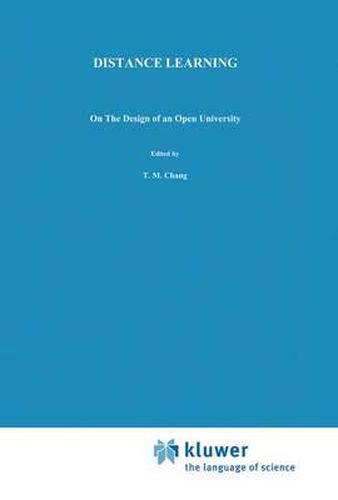Readings Newsletter
Become a Readings Member to make your shopping experience even easier.
Sign in or sign up for free!
You’re not far away from qualifying for FREE standard shipping within Australia
You’ve qualified for FREE standard shipping within Australia
The cart is loading…






This title is printed to order. This book may have been self-published. If so, we cannot guarantee the quality of the content. In the main most books will have gone through the editing process however some may not. We therefore suggest that you be aware of this before ordering this book. If in doubt check either the author or publisher’s details as we are unable to accept any returns unless they are faulty. Please contact us if you have any questions.
History The present book is a translation and in part an adaptation of a study the authors conducted for the Dutch Ministry of Education. Several years ago, the Dutch authorities decided to found an Open University, a system of distance learning especially suited to students only able or willing to devote part of their time to their studies, and, moreover, not generally capable of studying at fixed times or places. A preparatory committee was created, which published a preliminary report in 1 1978. This report was largely concerned with the kinds of courses the Open University should offer and the kinds of students it planned to enroll. The report also discussed possible teaching methods or media of the Open University. The predominant conclusion was that written instruction should constitute the basic teaching medium, and that other media (e. g. , computerized instruction or televi sion) were only to be added if the written medium failed to realize the desired teaching objectives. This preference was mainly based on considerations of cost, since the committee expected written instruction to be the cheapest alternative possible. Whether this is in fact true will be discussed later in this book. We were then asked to reconsider the different possibilities of teaching methods and media in more detail, in terms of their differential teaching effects, costs of application, and the committee’s preference for the print medium. Work was started on this assignment in 1978 and completed a year later.
$9.00 standard shipping within Australia
FREE standard shipping within Australia for orders over $100.00
Express & International shipping calculated at checkout
Stock availability can be subject to change without notice. We recommend calling the shop or contacting our online team to check availability of low stock items. Please see our Shopping Online page for more details.
This title is printed to order. This book may have been self-published. If so, we cannot guarantee the quality of the content. In the main most books will have gone through the editing process however some may not. We therefore suggest that you be aware of this before ordering this book. If in doubt check either the author or publisher’s details as we are unable to accept any returns unless they are faulty. Please contact us if you have any questions.
History The present book is a translation and in part an adaptation of a study the authors conducted for the Dutch Ministry of Education. Several years ago, the Dutch authorities decided to found an Open University, a system of distance learning especially suited to students only able or willing to devote part of their time to their studies, and, moreover, not generally capable of studying at fixed times or places. A preparatory committee was created, which published a preliminary report in 1 1978. This report was largely concerned with the kinds of courses the Open University should offer and the kinds of students it planned to enroll. The report also discussed possible teaching methods or media of the Open University. The predominant conclusion was that written instruction should constitute the basic teaching medium, and that other media (e. g. , computerized instruction or televi sion) were only to be added if the written medium failed to realize the desired teaching objectives. This preference was mainly based on considerations of cost, since the committee expected written instruction to be the cheapest alternative possible. Whether this is in fact true will be discussed later in this book. We were then asked to reconsider the different possibilities of teaching methods and media in more detail, in terms of their differential teaching effects, costs of application, and the committee’s preference for the print medium. Work was started on this assignment in 1978 and completed a year later.